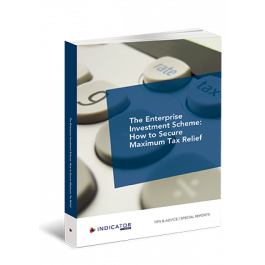The Enterprise Investment Scheme: How to Secure Maximum Tax Relief
A Tips & Advice Special Report about...
In a nutshell
This Special Report is the perfect tool to take full advantage of the tax-saving opportunities offered by the enterprise investment scheme (EIS). It examines the qualifying conditions in detail - from the perspective of both the company and the investor - and breaks them down in a way that is easy to understand. It’s fully up to date for the 2023/24 tax year.
In detail
This Special Report covers, for example:
- The risk to capital condition
- Restrictions for existing shareholders - and how to sidestep them
- The concept of a maximum age for the issuing company
- Long-term objectives - showing the intention to grow and develop
It gives answers to questions such as:
- How do I secure immediate protection from inheritance tax using EIS shares?
- How do I reduce my capital gains tax rate using the EIS when selling buy-to-let property?
- Why would using the EIS alongside my profit extraction strategy result in big savings?
Enriched with case studies and handy documents and checklists, this Special Report is the invaluable tool that investors and companies looking for investors have been seeking for years.
We've created this Tips & Advice Special Report especially for...
Investors, companies looking for investors and anyone that wants to:
- Take full advantage of the tax-saving opportunities offered by the EIS
Tax advisors that want to:
- Provide valuable tax-saving advice to their clients on the EIS
You'll get the following free extras with this Tips & Advice Special Report...
An online service with ready-to-use documents
- To immediately apply our advice and solutions in practice
- That you can easily adapt to suit your own requirements
In this Tips & Advice Special Report you'll read about...
Table of contents
1. EIS - the four EIS tax breaks
1.1. What are the four tax breaks?
1.2. How does the income tax relief work?
1.3. What is the CGT deferral?
1.4. What about CGT exemption?
1.5. And loss relief?
1.6. What is the overall effect of these reliefs?
2. Income tax relief - the qualifying investor
2.1. What are periods A, B and C?
2.2. What is the termination date?
2.3. When is the share issue date?
2.4. What is a qualifying investor?
2.5. How is a connection to the issuing company established?
2.6. What is an associate?
2.7. Working for the company - is it an automatic bar?
2.8. Can directors make investments via the EIS?
2.9. How does the unpaid director concession work?
2.10. What about the business angel concession?
2.11. Is there a cap on the pay a director can receive?
2.12. What does “involved in carrying on the trade” mean?
2.13. How can the interest in the company cause a connection?
2.14. What about the connection due to “certain arrangements”?
2.15. What is a linked loan and how can it prevent relief?
2.16. What about the requirement to make a genuine commercial investment that doesn’t involve tax avoidance?
2.17. What about restrictions for existing shareholders?
3. Income tax relief - the qualifying company
3.1. What conditions apply to the company?
3.2. Does the company have to be registered in the UK?
3.3. What is meant by financial health?
3.4. What is the trading requirement?
3.5. What is a qualifying trade?
3.6. Is achieving the unquoted status as simple as it sounds?
3.7. What about control and independence?
3.8. What is the gross assets test?
3.9. How many employees can I have?
3.10. Do I need to count seasonal staff?
3.11. What if one of my group companies is a property management company?
4. Income tax relief - general requirements
4.1. What are the general requirements?
4.2. What is the requirement in respect of shares?
4.3. What if there is a delay in payment?
4.4. Is there a maximum amount the company can raise via the EIS?
4.5. Could Acom avoid this by delaying the acquisition until after the investment date?
4.6. Why do I need to worry about the purpose of the share issue?
4.7. Can HMRC tell me how I have to use the money?
4.8. What if I can’t spend all the money by the deadline?
4.9. Is there an age restriction?
4.10. What is the minimum period related to?
4.11. What is the restriction on prearranged exits?
4.12. Is the tax avoidance requirement the same as for the investor?
4.13. And what are disqualifying arrangements?
5. The risk to capital requirement
5.1. What is the risk to capital condition?
5.2. How can I prove an objective to grow and develop in the long term?
5.3. What is “long term”?
5.4. What about proving the significant risk to capital?
5.5. Is the legislation of any use in terms of interpreting the condition?
6. After the investment: don’t lose the relief
6.1. Which of the conditions need to be continuously met?
6.2. What are these provisions?
6.3. What happens if the shares are sold early?
6.4. How is the relief withdrawn?
6.5. What if I only sell some of the shares?
6.6. What if the shares cease to exist because the company goes bust?
6.7. What if there is a takeover or the company undergoes a reconstruction?
6.8. What if the shares become subject to options?
6.9. When is value received, and how does it affect relief?
6.10. How is the reduction calculated?
6.11. What if the value is transferred unintentionally?
6.12. What about the provision for repayments of capital?
6.13. Is the company really prohibited from acquiring shares or trades?
6.14. How can relief be “subsequently found not to have been due”?
7. Capital gains tax reliefs
7.1. What is deferral relief?
7.2. Can any gains be matched and deferred?
7.3. What about gains I’ve already paid tax on from years ago?
7.4. Can anyone use deferral relief?
7.5. Does income tax relief need to be claimed as well?
7.6. Is there a cap on how much can be deferred?
7.7. How does the deferral work in practice?
7.8. What causes a deferred gain to come back into charge?
7.9. What would stop the shares remaining eligible?
7.10. What would cause a breach of qualifying conditions?
7.11. How much of the gain is revived?
7.12. How does the CGT exemption for EIS shares work?
7.13. Are there any restrictions on disposal relief?
7.14. What about the loss relief?
7.15. Is there anything else I need to be aware of with loss relief?
8. EIS planning: putting it all into practice
8.1. What is the process for claiming the relief?
8.2. What is advance assurance?
9. Case studies
9.1. Case study 1: how can I use the EIS to reduce tax on property gains?
9.2. Case study 2: can I get instant inheritance tax protection using the EIS?
9.3. Case study 3: how can the EIS be used to assist with profit extraction?
9.4. Case study 4: how can the EIS help realise value in my investment portfolio?
9.5. Case study 5: I use the remittance basis, how can the EIS allow me to remit income and gains free of UK tax?
10. Appendices
10.1. Appendix 1. Qualifying investor checklist
10.2. Appendix 2. Qualifying company checklist
10.3. Appendix 3. General requirements checklist
10.4. Appendix 4. HMRC guidance on the objective to grow and develop in the long term
10.5. Appendix 5. Table of value received and how to measure it
11. Documents
11.1. EIS relief claim
11.2. Letter for s.247 takeover clearance
11.3. CGT negligible value claim
11.4. Letter notifying reduction of EIS relief
11.5. CGT EIS deferral relief claim
11.6. Share loss relief claim
Special subscribers' offer
£90.00
£70.00
Only if you already have a subscriptionStandard offer
£90.00
Special subscribers' offer
£90.00
£70.00
Only if you already have a subscriptionStandard offer
£90.00

Got a question? Call Customer Services
(01233) 653500


 (01233) 653500
(01233) 653500 







